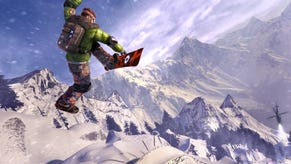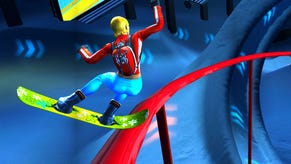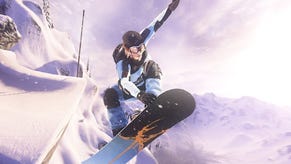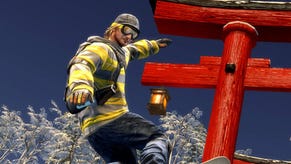Face-Off: SSX
Return of the Mac.
| - | Xbox 360 | PlayStation 3 |
|---|---|---|
| Disc Size | 3.8GB | 4.1GB |
| Install | 3.8GB (optional) | - |
| Surround Support | Dolby Digital | Dolby Digital, DTS, 5.1LPCM, 7.1LPCM |
It's difficult to over-emphasise the importance of the SSX series to players of a certain era. When the PlayStation 2 launched in 2000, its launch line-up was threadbare - outside of a small handful of semi-interesting titles from Japan, gaming thrills were in desperately short supply. The one highlight in a moribund launch was EA BIG's superlative SSX - a wonderfully over-the-top snowboarding game that dazzled players with beautifully designed courses, gloriously vibrant visual effects and a sublime control method.
Reaching its zenith with the following year's sequel - SSX Tricky - further tinkering with the formula made for some solid games but it was difficult to avoid the feeling that EA was introducing too much realism into a series defined by the extraordinary. The magic of SSX appeared to evaporate from the series just as the colour and spectacle drained away from the visuals; unbelievable as it may sound, SSX was becoming bland. With ideas running low and sales diminishing, EA canned the series.
Now it's back, and SSX is great once again - strong enough to claim a Eurogamer 9/10, where Simon Parkin fetes the free-flowing combo system that helped defined the series in days of yore, while emphasising the brilliance of modern innovations such as the competitive multiplayer modes.
In short, Eurogamer says that SSX is a must-buy, so which console platform offers the best package overall? The good news is that this is one of the closest cross-platform releases we've seen across all the long, hard years we've been at this game - but this is not exactly surprising. The all-new SSX isn't the technologically ambitious title that the original was back in the day - its most beguiling charms lie elsewhere.
"Aside from minor anti-aliasing differences and the odd almost-unnoticeable technical issue, SSX is equally as good on both Xbox 360 and the PlayStation 3."
To begin with, the game renders in a sub-HD resolution on both platforms, in combination with post-process anti-aliasing - our guess in this case would be NVIDIA's FXAA. This technique has both its strengths and its weaknesses. On the plus side, it's a supremely fast form of anti-aliasing, able to process the screen using just 1ms of GPU time - freeing up GPU resources and RAM for other tasks. It's a blur filter of sorts, but it's intelligently applied on high-contrast artifacts, often producing excellent results.
On the minus side, FXAA can only address the screen as flat 2D image - it doesn't have access to depth data, and on sub-pixel detail it can struggle, resulting in dot crawl. In this respect, traditional multi-sampling anti-aliasing (MSAA), applied as the framebuffer is being constructed, offers up higher image quality.
However, the Xbox 360 version of FXAA is more refined than its PS3 equivalent and this manifests in SSX via less pixel-popping/dot crawl than we see on the Sony platform. Thankfully this isn't especially noticeable during play - good news since this is probably the biggest difference between the two platforms.
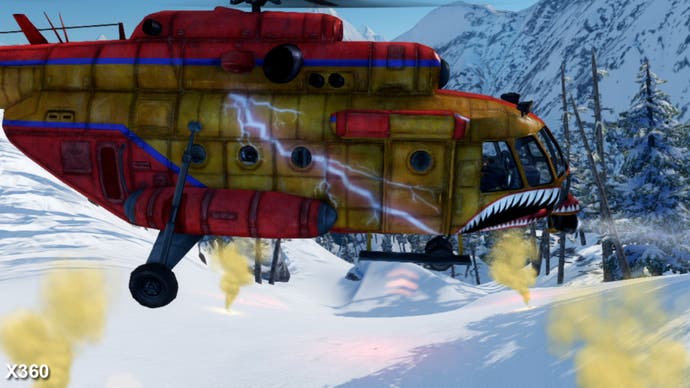


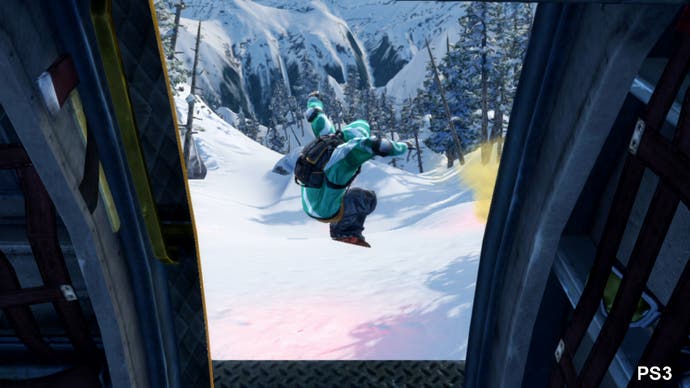
Because of the AA technique chosen by EA's development team, resolution analysis is made more challenging - but we're fairly confident that both games operate at 1120x585, the same resolution as Ninja Gaiden 2 on Xbox 360. This is around 60 per cent of a native 720p framebuffer and the reduced resolution gives the game a somewhat soft look, made less distinct still by blur induced by the FXAA. In theory, a framebuffer of this size should allow for 2x MSAA for "free" on the Xbox 360 (one of the reasons why the COD games operate at sub-HD resolutions) but the application of NVIDIA's post-process suggests that EA has adopted a deferred shading setup, which traditionally doesn't play very nicely with hardware multi-sampling.
A deferred approach to the lighting means that EA can deploy a large amount of dynamic lights within the environments without the performance impact you'd expect in a traditional forward renderer and, as a great many of the levels in SSX actually play out at night with landscapes dotted with flares and with racers sporting flashlights, this technology makes sense.
Post-AA pixel-crawl aside, you've really got to work hard to find even miniscule differences between these two games. Texture pop-in and shadow LODs are noticeable issues on both versions of the game, but the transition points are seemingly identical so no one version gains any kind of advantage here. Even shadow implementations - often a point where developers choose differing solutions one each console - give the impression of being identical.
Differences we did pick up on are mostly technical minutiae that'll have zero effect on your gaming pleasure - terrain height maps appear to show some differences, demonstrated most dramatically by the cut-scene shot below where the player's arm is more deeply submerged in the snow on the PlayStation 3. In the vast majority of our shots, snow accumulation appears to be different between the two machines - a curious if irrelevant difference. Another minor difference concerned the trails left by other racers: these seem to have higher resolution and more detail on the Xbox 360 in some cases.
"The first levels are very plain, lacking in features and landmarks - a far cry from the explosion of colour and bright light we saw in the original SSX and its legendary Trickier sequel."
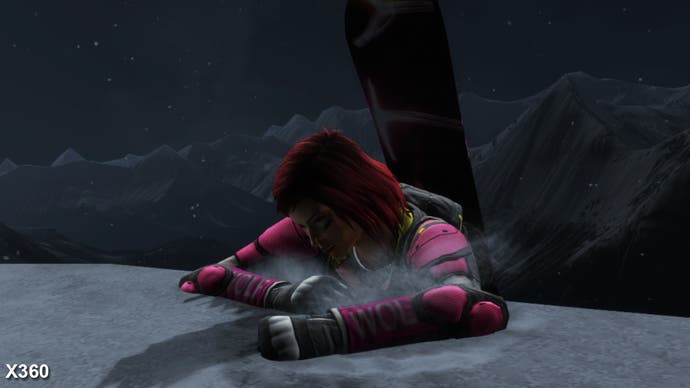



It's safe to say that it took quite a while for us to warm to SSX - and a lot of our initial indifference comes from a certain blandness that makes this game look more "On Tour" than "Tricky". The first levels are very plain, very grey, lacking in features and landmarks - a far cry from the festival of colour and bright light we saw in the original SSX and its legendary, trickier sequel. On the plus side, this does at least mean that the sub-HD resolution is nowhere near as much of an issue as it is on other titles - there's little in the way of intricate artwork to compromise with the lower pixel count, and the upscale/post-process AA blurring is a good match for the overall look of the game.
If this article is giving you the idea that we're not hugely impressed with SSX, it should be stressed that this is clearly a game that plays better than it looks - and there are many times where the feelings of sheer, majestic gameplay the original SSXs gave you returns in full force, and even exceeds it.
Where the game excels is in its refined implementation of that brilliant control system - the classic PS2-era control system, but the new system built around the dual analogue sticks works well too and allows for much smoother combos. New additions to the core gameplay also hit the spot: while the oxygen tank required for high-altitude locations doesn't seem like a whole lot of fun, the implementation of the wingsuit is nothing short of sensational. A stunning concept beautifully realised. Going back to SSX Tricky to ensure that nostalgia wasn't colouring our views too much, the refinement in the control system is clearly the highlight: smoother, less brutal and more intuitive.
The technical make-up of the game may not set any new standards but at the very least the compromises do appear to result in an absolutely rock-solid level of performance. We tested SSX across a number of different races, including the new downhill avalanche sections, and found that the frame-rate was a consistent 30 frames per second from start to finish with zero deviation during gameplay. This is in contrast to the epoch-making Tricky, which targeted 60Hz, though was prone to some severe drops in performance as you'll see on the video further down the page.
"The Mount Fuji bonus level is a PS3 exclusive in North America, a GAME exclusive on PS3/360 in the UK and available to all in Europe on both consoles."
The new SSX maintains a remarkably consistent performance regardless of platform, resulting in a solid response from the controls. However, the lack of additional post-processing effects such as motion blur (on anything other than the boost effect) does mean that SSX isn't quite as smooth from a perceptual standpoint as other 30FPS titles.
Bizarrely, perhaps the biggest difference between the two SSX console games is geographical rather than technical. In North American territories, the PlayStation 3 version of the game possesses exclusive content in the form of an additional course: Japan's Mount Fuji, which offers three different race variations. This is entirely absent from the Xbox 360 version of the game unless you live in Europe where you get it as standard. However, the situation changes once again if you're in the UK as it appears that the Fuji stage is a bonus only found in the Limited Edition sold by GAME and GameStation.
In terms of whether the level itself is worth having, that's a bit of a "tricky" one as our review code didn't have it unlocked, but based on the captures circulating, it looks like a level worth having. Clearly the segregation of content in such a manner is going to prove divisive: this isn't PS3-exclusive content as it's obviously available on the Xbox 360 too, so for North American gamers, arbitrarily locking out at least half of your potential audience can either be viewed as a canny move by Sony or a lousy one from EA, depending on which system you own. From a Face-Off perspective though, as the games are so similar, if you're based in the USA or Canada and have the choice, the PS3 version is the one to get - it's a free level, after all.
For the UK, the notion of restricting worthwhile content to certain retailers is surely counter-productive. It seems unlikely that customers are going to be thinking warm and fuzzy thoughts about GAME if they're being compelled to buy it there in order to get the full game package - especially when their EU cousins get the game in its entirety as standard. As it stands, GAME does appear to be one of the most expensive retailers for SSX - but as we're talking about an additional £1 or £2 over the ShopTo or Amazon prices, at least the premium for the "Limited Edition" isn't as high as it might have been.
Overall though, corporate shenanigans and lockout deals aside, SSX is a beautifully playable game that's well worth consideration on either platform. Neither version commands any kind of appreciable technical advantage over the other, so you're good to go regardless of console. It's just a shame that there's no PC release to consider - we can't help but think that a 60FPS option might have helped make a great game better still and would be entirely consistent with the original SSX concept.


